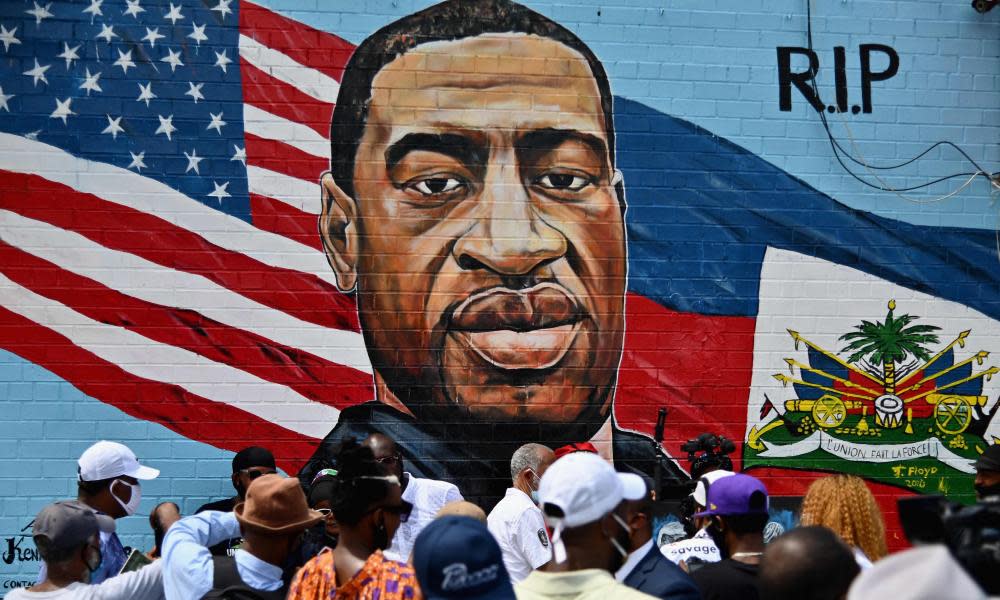Trump twists stats on police brutality: 'more white people' are killed

Donald Trump, in an interview aired Tuesday, pivoted when asked a question about the police killing of George Floyd, a Black American, which has sparked major national protests, to point out that white people also get killed by law enforcement in the US.
In a controversial moment that had echoes of his comments on white nationalist marchers and counter-protesters in Charlottesville, Virginia, in 2017, when he said there were “fine people on both sides”, the president did not take the opportunity to talk about the problem of racially-motivated police brutality on Tuesday but switched to talk about white victims.
He then inaccurately argued that white Americans are dying more often at the hands of police than Black Americans.
Related: Trump celebrates Fourth of July by stoking division over pandemic and race
Trump was asked about the issue in an interview with CBS News’ Catherine Herridge.
She began: “Let’s talk about George Floyd, you said George Floyd’s death was a terrible thing.”
“Terrible,” said Trump.
Then Herridge followed with: “Why are African Americans still dying at the hands of law enforcement?”
The president immediately pivoted.
“And so are white people. So are white people,” Trump said in response. “What a terrible question to ask. So are white people. More white people by the way. More white people.”
The President told @CBS_Herridge that "more White people" die at the hands of law enforcement in this country than African Americans:https://t.co/yvT0fqJk2B
— Weijia Jiang (@weijia) July 14, 2020
Herridge’s question came in the aftermath of weeks of protests as a result of Floyd’s killing while the police were trying to arrest him in Minneapolis in May. His death was filmed by a member of the public as bystanders were kept at bay while pleading with officers to stop restraining Floyd, who was begging for his life and saying, “I can’t breathe.”
The officers were fired but only later arrested and charged . The killing sparked enormous protests in towns and cities across the US and spurred urgent calls for sweeping police reform by both lawmakers and activists. Only minimal reform has come about yet, amid renewed debate and a reignited Black Lives Matter movement in the US and internationally.
Trump’s claim about more white people being killed by police in the US is misleading.
The Guardian’s investigative project The Counted in 2015-2016 that set out to record all people in the US killed by police showed that Black people in America were more than twice as likely to be killed by the police than white people.
And in 2016 Black men ages 15-34 were nine times more likely than other Americans to be killed by law enforcement officers, and they were killed at four times the rate of young white men.
A similar 2016 analysis by The Washington Post also found that African Americans are 2.5 times as likely to be shot and killed by police offers as white Americans.
Another study published in the American Journal of Public Health in 2018 found that African Americans are 3.5 times as likely to be killed by police compared to white people.
At the height of the protests over Floyd’s death Trump repeatedly framed it more as manufactured violence against police and law enforcement officials fueled by Democrats, anti-fascist radicals and his political opponents. He focused most of his criticism on pushes to take down Confederate monuments and rename military bases honoring Confederate generals.
Even as Republican and Democratic lawmakers in Mississippi worked together to replace the state flag with one that does not include the Confederate insignia, Trump has argued that the flag is not offensive to African Americans or a symbol of black oppression.
“Well people love it, and I know people that like the Confederate flag, and they’re not thinking about slavery,” Trump said in the same interview.
He has also criticized the banning of the Confederate flag at Nascar events and scorned the veracity of a noose found in the garage of Bubba Wallace, the only full-time Black driver on the stock car racing circuit. There has been a federal investigation into the noose situation, and a response from Wallace calling for “love over hate” after the president attacked him and asked him to apologize.

